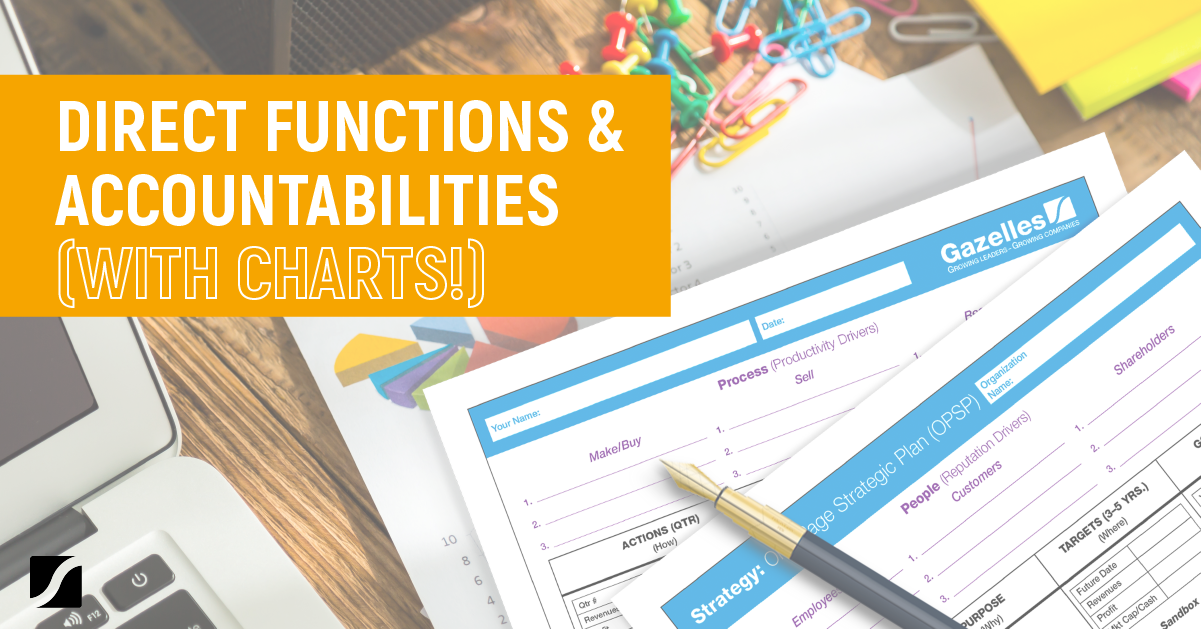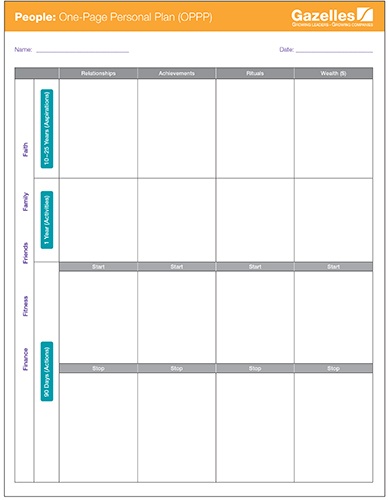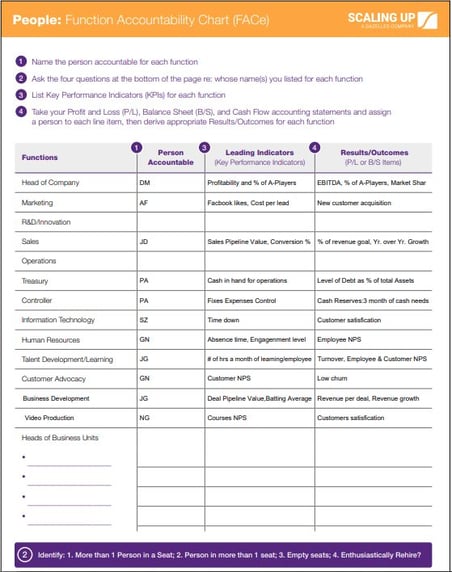How To Direct Functions & Accountabilities In Your Business (With Charts!)

As a company scales up, the toughest decisions involve people and their changing roles in the organization.
Loyalties, egos, and personal friendships make these decisions even more difficult when the company faces a situation in which it has outgrown some of its early leaders.
In this article, we’ll lay out the evolving leadership dynamics of a growing business and the functions and processes needed for that business to scale. I’ll also share some tools to help establish those processes.
Your Organization Is a Growing Organism
Remember the days when your start-up team was crammed into a single office like clowns squeezed into a Volkswagen?
Now, you may have 50 (or 1,500) employees. It’s infinitely more difficult to know how to divide up into teams and set clear accountabilities. Worse, both customers and employees may seem confused about how to navigate your organization.
Your CEO can take a clue from nature to solve these problems.
Human organisms are made up of billions of cells (versus just a few specialized ones) for good reason: A cell can only get so big to stay healthy. Once it reaches a certain point, the outer membrane won’t have enough surface area to bring in nutrients and eliminate waste. The cell will start to die from the inside out (like big bureaucracies!).
This means that the cell must divide. So, too, must your company or it won’t be able to function healthily. At the same time, just as no cell can be too far from the blood supply, no team can be too far removed from the action of the marketplace.
This is the main principle underpinning effective organizational design. If you want to increase the surface area of your company, give the maximum number of employees a chance to interact with the marketplace.
Each cell within your organization must have someone clearly accountable for it. But that doesn’t mean this person is the boss or gets to make all the decisions.
Note the differences between accountability, responsibility, and authority. Though spelled differently, these terms are often and arbitrarily used interchangeably.
Accountability
Accountability belongs to the ONE person who has the “ability to count” - who is tracking the progress and giving voice (read: screaming loudly) when issues arise within a defined task, team, function, or division.
It doesn’t mean he or she makes all the decisions (or even any decision) - which is why people often talk about leaderless teams. However, someone must still be accountable. That’s the rule: If more than one person is accountable, then no one is accountable, and that’s when things fall through the cracks.
Responsibility
Responsibility falls to anyone with the “ability to respond” proactively to support the team. It includes all the people who touch a particular process or issue.
Authority
Authority belongs to the person or team with the final decision-making power.
These definitions matter because of how you'll apply them with following tools, which I'll dive into now.
Scale Up Your Organizational Design (With Charts!)
Getting accountabilities clear throughout your organization is critical.
To help you, there are 3 one-page People tools you can use to help you identify (and prioritize) the People challenges to scale up your organization:
The One Page Personal Plan (OPPP)
As busy executives, if we’re not careful, we can find that our personal lives end up neglected. That’s why I’m a big believer in establishing personal priorities and aligning them with your professional goals.
We encourage each leader of a company to complete their own OPPP. Just as there are 4 decisions you make to build a thriving company (People, Strategy, Execution, and Cash), there are parallel areas in your personal life.
The four columns on this tool represent these areas: Relationships, Achievements, Rituals, and Wealth.
The Functional Accountability Chart (FACe)
This is the second one-page People tool. The Functional Accountability Chart (FACe) focuses on making sure you have the right butts in the right seats at the top of the organization (“right people doing the right things right”).
It also walks you through to assign specific accountabilities for the company’s functions and business units. When completed, this one-page accountability tool helps you diagnose where you have people and performance gaps on the leadership team.
Have each person on your executive team fill in the first blank column by noting who they think is accountable for each function. Once finished, compare the lists to see if there’s agreement and address the questions at the bottom of the page. Then you’ll work together to fill in the next columns.
Download your own copy of the FACe tool here
The Process Accountability Chart (PACe) -
This is the third one-page People tool to help you delineate the various process accountabilities in your organizations.
The Process Accountability Chart (PACe) lists who is accountable for each of the 4 to 9 processes that drive the business and how each process will be measured to guarantee it’s running smoothly. These would be processes like developing a product, generating leads, closing sales, finding new talent, and billing.
To complete the chart, get your executive team together and identify the 4 to 9 processes driving your business. Next, you’ll need to figure out who is accountable for each process, which may take some thinking. Finally, you will decide and define a few KPIs to track each process.
Click here to download your own copy of the PACe tool
Structure The Org Beyond Functions
The first natural organizational split is by functional area.
But once the business gets above 50 employees, you also need to start aligning teams around product groups, industry segments, and geographical regions. This is commonly called a matrix organization. Visualize functional groups running vertically and business units running horizontally.
The pressure to create these new business units will usually come from customers. They don't know who to call to get help, they get the runaround when they finally reach someone, or they feel overwhelmed by the avalanche of communications that come from multiple business units. Employees may not know from whom to take direction.
Unless you get your accountabilities straight, productivity and innovation will slow. You’ll waste a lot of time oscillating between centralizing and decentralizing various business units and shared functions.
Restructure Leadership
To navigate this organizational transition, you need to change your leadership structure.
The functional heads - like the directors of marketing and IT - who have been used to driving the business, have to step up to be more like coaches/advisors to the business unit leaders. And the business unit leaders need to start running their units as if they are mini - CEOs.
This transition is hardest for the traditional functional leaders - especially those who were around in the earlier start-up phase. They have to go from telling to selling, as they manage their teams. And they need to spend more time outside the organization garnering best practices and then come back and spread what they’ve learned among the business unit leaders.
Most importantly, they have to earn the respect of the business unit leaders because of their knowledge, not just their position. That way, if they suggest a common IT system, for instance, it’ll be an easy sell, not a battle against skeptical business unit leaders.
This transition is hard. Often, it’s best to have some of the original functional leaders transition to running business units - maybe head up expansion to a new country or lead the launch of a new product line - where they can maintain operational control. You don’t want your business unit heads to be weak “yes” people who kowtow to the functional leaders.
Who’s Boss In Scaling Organizations?
Once you set up these groups, you’ll need to figure out which employees belong in each. If you aren’t clear on this, your employees won’t be either.
The key principle here is being clear who decides whether an employee gets a raise or promoted.
The mistake is to leave this decision to the functional heads. For instance, say Tom is providing marketing support to several product lines. The functional head of marketing for the company must see her role as a trainer/coach to Tom while making it clear that his performance is based on feedback she gets from the heads of the business units he serves and not on what she thinks.
This way he remains responsive first and foremost to the business units.
Conclusion
Once you’ve set up clear accountabilities, you’ll know very soon if you’ve got it right.
Customers will be happy, and everyone on your team will be clear on their role in serving customers. And when you notice a pattern of negative feedback from customers or see internal signs that your “cells” are not healthy - it’s time to revise your charts (FACe and PACe) again.
Remember, your company is a living organism that needs to survive in an environment that’s always changing. To thrive, it’s got to be able to adapt.


![[OPPP] Horizontal-1](https://blog.growthinstitute.com/hubfs/%5BOPPP%5D%20Horizontal-1.png)



